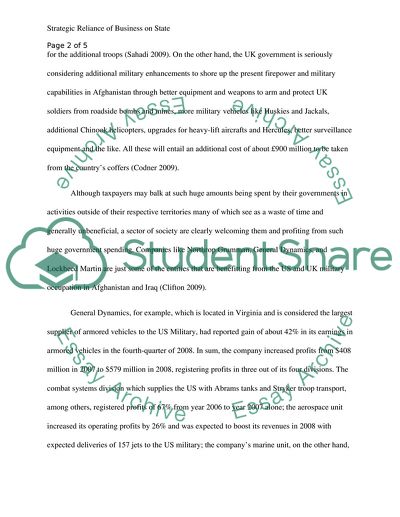Cite this document
(“The Afghanistan and Iraq Case: Strategic Reliance of Business on State Research Paper”, n.d.)
The Afghanistan and Iraq Case: Strategic Reliance of Business on State Research Paper. Retrieved from https://studentshare.org/politics/1731647-how-does-the-occupation-of-irag-and-afghanistan-by-britain-and-the-us-demonstrate-the-strategic-reliance-of-business-on-the-state-draw-in-your-answer-from-news-stories-and-analysis-on-the-occupations-of-iraq-and-afghanistan
The Afghanistan and Iraq Case: Strategic Reliance of Business on State Research Paper. Retrieved from https://studentshare.org/politics/1731647-how-does-the-occupation-of-irag-and-afghanistan-by-britain-and-the-us-demonstrate-the-strategic-reliance-of-business-on-the-state-draw-in-your-answer-from-news-stories-and-analysis-on-the-occupations-of-iraq-and-afghanistan
(The Afghanistan and Iraq Case: Strategic Reliance of Business on State Research Paper)
The Afghanistan and Iraq Case: Strategic Reliance of Business on State Research Paper. https://studentshare.org/politics/1731647-how-does-the-occupation-of-irag-and-afghanistan-by-britain-and-the-us-demonstrate-the-strategic-reliance-of-business-on-the-state-draw-in-your-answer-from-news-stories-and-analysis-on-the-occupations-of-iraq-and-afghanistan.
The Afghanistan and Iraq Case: Strategic Reliance of Business on State Research Paper. https://studentshare.org/politics/1731647-how-does-the-occupation-of-irag-and-afghanistan-by-britain-and-the-us-demonstrate-the-strategic-reliance-of-business-on-the-state-draw-in-your-answer-from-news-stories-and-analysis-on-the-occupations-of-iraq-and-afghanistan.
“The Afghanistan and Iraq Case: Strategic Reliance of Business on State Research Paper”, n.d. https://studentshare.org/politics/1731647-how-does-the-occupation-of-irag-and-afghanistan-by-britain-and-the-us-demonstrate-the-strategic-reliance-of-business-on-the-state-draw-in-your-answer-from-news-stories-and-analysis-on-the-occupations-of-iraq-and-afghanistan.


